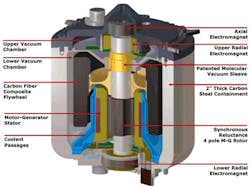Power Quality on the Fly
By Frank DeLattre
The caliber of power-quality systems is often a defining factor for businesses that now endure the effects of power-related problems. Even a brief outage can cost millions, particularly in light of lost customer confidence. And, while utility rates keep increasing, the quality and reliability of utility power is decreasing. Mission-critical equipment, from data servers to medical-treatment systems, demand continuous clean power - even a split-second glitch can cause costly problems.
Uninterruptible power supply (UPS) systems are the obvious answer, but the challenge is to find enough space with the proper weight support to install dozens or hundreds of hazardous lead-acid batteries. Battery arrays need constant, energy-sapping temperature control around the clock, because running valve-regulated lead acid (VRLA) batteries just 10 degrees F. above their optimum setting cuts life from 4 years to 2 years. Batteries can also vent toxins and hydrogen; you might have to plan on plunking down more cash for dedicated HVAC and hydrogen sensors so you don't blow the roof off of your building (like a former data center near Sacramento, CA, did not long ago).
UPS batteries can be unreliable. Every time they're used, even for a split second, the more likely it is that they will fail the next time they're called upon. Like old-fashioned Christmas lights, a cell failure in one battery renders the whole array inoperable.
These issues motivated the industry to develop alternatives that are reliable, energy efficient, and less costly to operate. The advent of commercially viable flywheel energy storage systems in the late 1990s (combined with recent technological advances that have boosted value and reliability) has flywheels literally flying off of the shelves.
First-generation designs (still sold today) use large metal "pucks" to store energy kinetically. The system's motor-generator and vacuum pump continuously draw 3,000 watts to keep spinning. When voltage falls below a set point, the flywheel motor-generator instantly delivers the missing energy. The flywheel carries the load throughout the utility disturbance (most of which last less than 1 second) or until the back-up generator comes online anywhere from 6 to 20 seconds into the event.
The latest flywheel designs take advantage of carbon-fiber composites that are lighter, stronger, and safer, packing more clean energy storage into a much smaller footprint. These energy-efficient flywheels use 90-percent less standby energy than steel puck systems, saving thousands in utility costs per year per unit. Since the puck is smaller and lighter, bearing-free magnetic levitation within a factory-sealed high vacuum increases efficiency and eliminates the costly and frequent needs of steel puck designs for bearing and vacuum pump service. Over a 20-year design lifespan, cost savings from a hazmat-free flywheel vs. a 5-minute VRLA battery bank range from $100,000 to $200,000 per flywheel deployed.
Frank DeLattre is senior vice president of sales and service at Chatsworth, CA-based Pentadyne Power Corp. (www.pentadyne.com).

